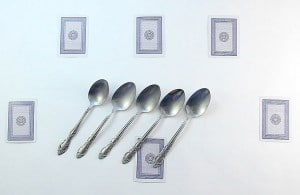The acquisition of new vocabulary is essential in terms of overall language advancement. However, there is always a need to review active words from time to time in order to use them fluently in speech. Here, we will present a couple of great vocabulary revision games which will perk up every classroom. Through these games the learners will feel how fun, entertaining and effective the learning process can be.
1. Charades
Charades is a fun and cool revision game. Students need to practice their acting skills to explain the words. This game is extremely easy to organize with minimal advance preparation. The only thing to be ready for is to keep a collection of vocabulary cards for the words you have studied.
The class is divided into two teams. Each team member takes turns acting out one of the words from the vocabulary set and explains it by acting out the word. If his or her own team can’t guess the word, the opposite team gets the chance to guess it. Each right answer equals one point.
Skyeng ищет преподавателей английского. Подробности по ссылке: Skyeng
2. Pictionary
Pictionary is also an entertaining game to play for vocabulary review. The rules are similar to those of charades except that instead of acting out the word, it is drawn on the board.
3. Bingo
Bingo can serve as a good revision game. From my experience, most of the groups/students like playing bingo because it gives them the chance to reflect on the words they have digested.
Students are given a blank bingo board and are asked to put the review words into the squares randomly. The teacher puts the active words in a hat or a box, takes them out one by one and defines them. If the student has a word corresponding to the definition, he crosses it out on his bingo board. When someone gets five squares in a row, they should shout, “Bingo!”
Check these articles out as well:
4. A memory style
A memory style card game can be another effective way for reviewing vocabulary. It requires some preparation before the game starts. For each word to be reviewed, one card should have the target vocabulary word and another card should have the definition of the word. You also need to have a big playing grid where you put the words and their definitions face down.
Each person turns over two cards each turn trying to find a match. If the cards do not match, he turns them over again and the next person tries to find a match. If he succeeds, he keeps the cards and gets an additional turn. The player with the highest number of cards at the end of the game wins.
The game can be modified even further. If you have accumulated enough synonyms or antonyms to the target vocabulary, you can practice matching target words to their antonyms or synonyms.
5. Categories
Categories is another awesome revision game which will make students energized and empowered. What they need for the game is to draw 4-6 columns on their paper and write a category at the top of each column. Categories fit the topics covered during the course. For example, if you have covered the business topics of Marketing, Work and Leisure, Ethics, Human Resources, Travel, you write these topics as categories.
You time the students and ask them to write as many words as possible under each category. As a further modification, choose a random letter and write it on the board. Give students enough time to write down a word for each category that starts with that letter.
Экономьте время на подготовку к урокам и проверку домашних заданий со Skyeng. Удаленный формат занятий, защита от внезапных отмен и график, который настроен специально под вас. Присоединяйтесь к нашей команде. Подробности по ссылке: Skyeng
6. Letter scramble
Letter scramble will make students really competitive and super fast. What you need is to take a list of words that your students have recently learned and write a scrambled version of each on the board. Students need to unscramble the words on their paper. The first one to finish deciphering all the words wins.
7. Stop the bus
Stop the bus is a cool game my students adore. I usually divide the class into 2-3 teams. One student from each team. This student sits on a chair facing his peers. Then from behind the student in the hot seat, show the other students a word from the lesson. The other students must try to describe what the word is without saying the actual word. And the student in the hot seat must guess.
The student who guesses the word shouts out “stop the bus” and checks the word with the teacher. If correct, the team gets a point. If wrong, other teams have the chance to guess the word by writing their versions on a piece of paper and passing the papers to the teacher.
8. Puzzles
Puzzles is another cool and easy tool to review the material in an effective way. What I like about this way of vocabulary revision is that students can work in pairs or groups while trying to find words matching the definition in the crosswords. They learn by listening to each other, cooperating to find the right answer. In this way, they both review the material and improve their teamwork skills.
Follow this link to get templates of different types of puzzles.
We also recommend watching a video with Alexei Konobeev. The speaker shared games to help your students remember new vocabulary. These games do not require special training and you can adapt them to any age and level.
We hope that all these games would serve their best to liven your vocabulary revision sessions and make them more meaningful and effective.
Which of these games have you tried? Which ones have you picked up for your next revision slot?
Free Online Memory Matching Games for English Practice
Word Games Go Here
Search Our Site
Custom Search
This post contains affiliate links.
Vocabulary card games are a fun and easy-to-use way of teaching target vocabulary to preschoolers and elementary students. But their practical usefulness greatly depends on how they are used, for example:
- Whether there is enough repetition (especially for unknown words)
- If the words appear in context (other related words, visual context, examples of use of the word…)
- Whether the rules make you actually use the words (nothing beats pratice to ensure that a new notion is firmly remembered)
- Whether you can target specific words that you want to teach, etc…
Needless to say, the existing games on the market do not have all these qualities, and I was really curious to know and share with you which ones fare best in this regard (in my opinion of course).
The vocabulary card games in this table are arranged according to the learner’s age range. I hope that this comparison table will help you find the best game for your family or class.
| Game | Age | Players | For | Price | Rating |
| English Vocabulary Builders | 4-6 | 2-6 | Families | $$$$ | ★★☆☆☆ |
| Can Do! Vocabulary | 6-8 | 2-4 | School | $$ | ★★★☆☆ |
| Super Sleuth | 8-12 | 2-4 | School | $$ | ★★★☆☆ |
| Triple Talk Vocabulary Cards | 7-9 | 2-4 | School | $$$ | ★★★★☆ |
| Can Do! Prefixes & Suffixes | 8-10 | 2-4 | School | $$ | ★★★★☆ |
| Just for Laughs | 8+ | 2-4 | Families, School | $$$ | ★★★★☆ |
| Classwords | 7-11 | 2-8 | School | $$ | ★★★☆☆ |
| Word Waffle | 10-11 | 2-4 | Families | $$ | ★★☆☆☆ |
| I Have. Who Has? | 10-12 | 2-4 | School | $$ | ★★★☆☆ |
| Say It! | 10+ | 3-8 | Families | $$ | ★★☆☆☆ |
| Word Teasers | 8+ | 2-10 | Families | $$ | ★★★☆☆ |
| Scattergories | 7+ | 2-4 | Families | $$ | ★★★★★ |
| Wordsmithery | 14+ | 2 | Families | $$$ | ★★★☆☆ |
| Early Learning Language Library | 3-5 | 2-6 | Families, School | $$ | ★★★★☆ |
Can Do! Vocabulary (Lakeshore Learning)

★★★☆☆
For Teachers | Age 6-8 | 2-4 Players | Grade 1-2
In Can Do! Vocabulary Game
It contains 60 question cards, 44 game tokens, and a canister. The lid of the canister is used as a spinner.
The first player to obtain 10 tokens wins the game.
I recommend this game with children aged 6-7 years old because
- The multiple choice answers are relevant (not just here for fun but relate to the type of question)
- Answer cards enable self-correction, which is great at school
- The game is rather fast paced and very simple
Classwords (Edupress)
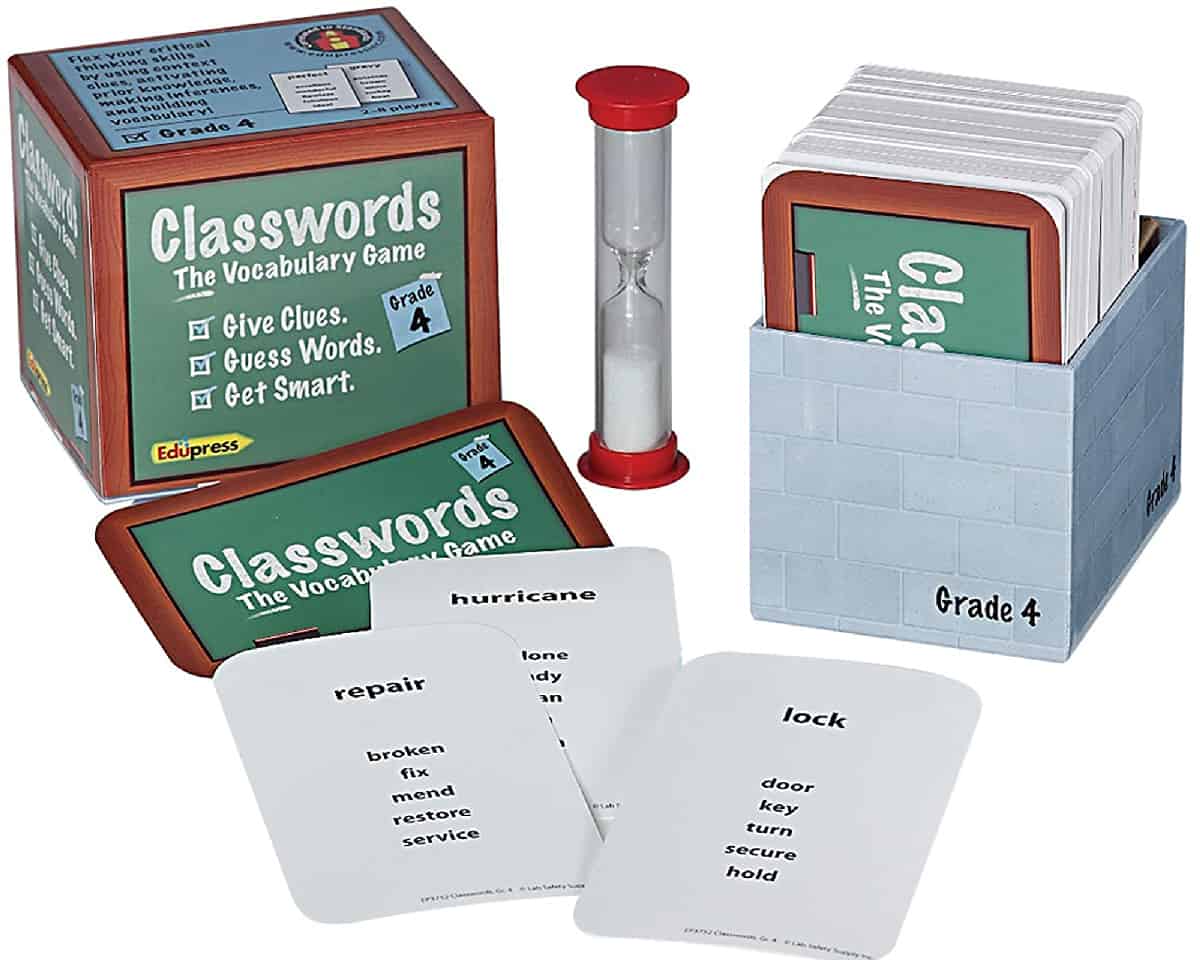
★★★☆☆
For Teachers | Age: 7-11 | 2-8 Players | Grade 2 to 6 according to the version
In Classwords,
This game can be used for practicing vocabulary in short sessions: It is easy to set up and can be played with 2-4 players on each team.
the strong points of the game are that:
- The words of a given card are in the same theme
- The guessing involved is intriguing for the children
- There are versions of the game for grade 2, 3, 4, 5 and 6 (here the Grade 4 version is shown)
Say It! Game (Gamewright)

★★★☆☆
For Families | Age 7+ (with my tweak, otherwise 10+) | 3-8 Players
Say It!
In Say it, players pick a pair of cards (among 200) and compete to propose an answer that fits the pair of cards within 30 seconds (a timer is included).
For example, the categories are “something sticky “and “that you find in couch cushions”. Tokens are given to players with the most clever or funniest answer. One token is equivalent to one point and the player with the highest score at the end of the game wins.
When you play with younger children, I recommend not using the tokens. This way, you do not count the points, and the aim of the game is just to have fun together. Of course, there is a second, less obvious aim, which is to learn new words from older players.
English Vocabulary Builders Super Deck Card (Strong Learning)

★★☆☆☆
For Families | Age 4-5 | 2-6 Students
English Vocabulary Builders Super Deck
- Animals
- Clothing
- Colors and Shapes
- Foods
- Numbers
- Body
Each deck contains a word list card and an “Old Maid” card.
The sets are relevant for children at pre-kindergarten or Kindergarten because the vocabulary is very simple and should be known by age 5. I do not recommend using them with 6-year-old children as there is no progression in the difficulty of the spelling.
Scattergories Categories (Rejects from Studios)
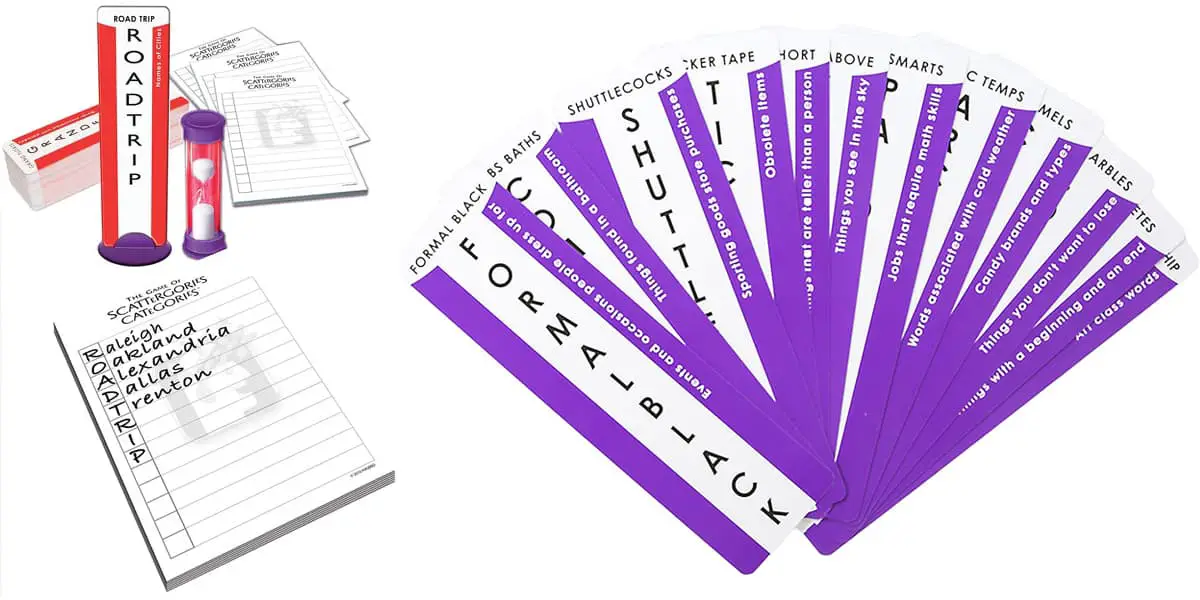
★★★★★
For Families | Age 7+ (with my tweak) | 2-4 Players
In Scattergories Categories
- Start with the letters on the word on the card drawn at the beginning of the round.
- Fit with the phrase
For instance, the word is “MARBLES” and the phrase is “Things you don’t want to lose”. Players must write on the pad things that they don’t want to lose that start with M, A, R B, L, E, and S.
Each answer that does not match another player’s answer scores one point. The first player to obtain 25 points wins the game.
The 125 cards enable to draw 250 words/phrase challenges.
I recommend Scattergories Categories because:
- Phrases can hint to specific themes that you want players to work on. To achieve this, you can keeping in the game only a subset of the 250 words, or invent new “word – phrase” pairs
- The scoring mechanism encourages to propose not too obvious words that nevertheless fit with the phase. This makes it very likely that younger players will learn new words from older ones
- Players can review the words on their pads later (great for debriefing the game)
The problem with players of different ages is that younger players have a much more limited vocabulary and will be at a disadvantage (of course they will be discouraged and will not want to replay the game).
So the standard rule is OK with players from the same age (for example the same class).
I have my “secret sauce”.
To play with children of different ages, just make the number of points required to win depend on the player’s age. I recommend (from 7 Year-old to 15 Year-old) a number of points equal to twice the age minus 5 (for example, 15 points for a 10-year-old). 15 year-olds and older should do 25 points to win.
This tweak enables children as young as 7-year-old to play the game, which was not intended originally (the publisher recommends Scattergories from 10 and up).
I Have. Who Has? (Teacher Created Sources)
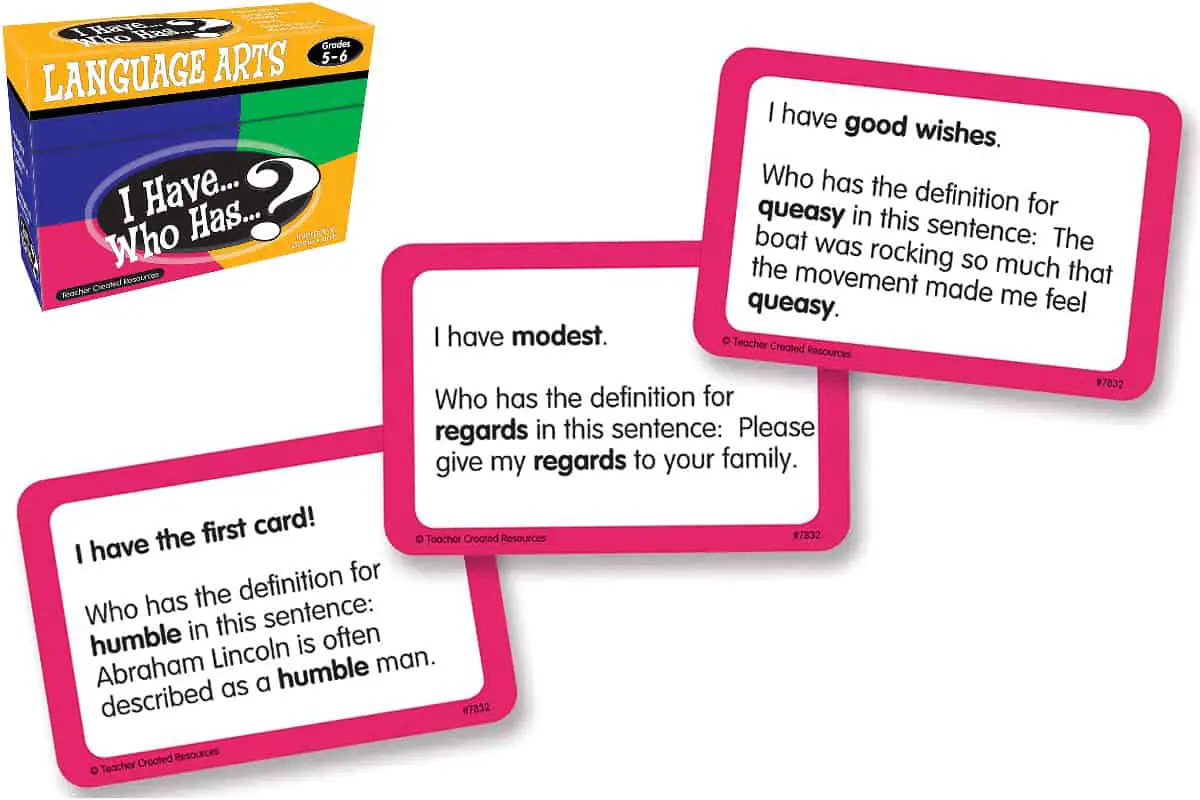
★★★☆☆
For Teachers | Age: 10-12 | 2-6 Players | Grade 5-6
In I Have. Who Has?
The 37 cards can be used as a warmup or enrichment activity in grades 5 and 6.
“I Have Who Has” is a classic in the classroom, and this one is interesting as there is a real challenge in finding the related word.
Word Teasers (Word Teasers)
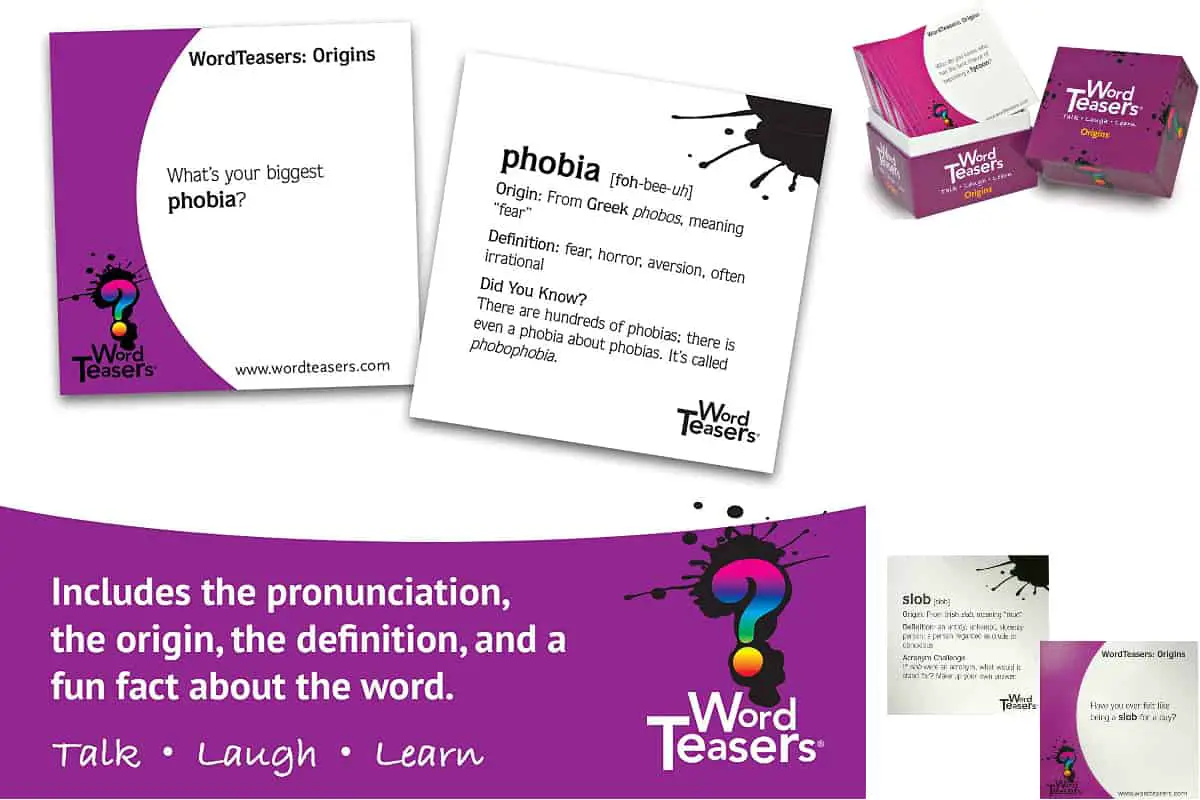
★★★☆☆
For Families | Age: 8+, according to version | 2-10 Players
Word Teasers
- As a vocabulary quiz game, using the word’s definition on the back side of the cards (when available)
- As a conversation starter, using the question on the front side of the cards
- As a synonym quiz game, using the list of synonyms (when available)
- Through the other infomation on the card backs, which depends on the version of the set:
- Small Fry (8+): “fun fact”
- Junior (9+), Middle School (11+) & SAT Vocabulary (13+): pronunciation, definition, function and synonyms
- Origins (13+): pronunciation, definition, origin (etymology) and “fun fact”
Although they are just flashcard sets, “Word Teasers” are really valuable because of the information on the cards which is well-chosen, and the versions of the game by age group.
Can Do! Prefixes & Suffixes (Lakeshore Learning)

★★★★☆
For Teachers | Age 8-10 | 2-4 Players | Grade 3-4
Can Do! Prefixes & Suffixes
Players draw a card according to the category drawn by the spinner. If they answer the question correctly, they receive tokens. You might want to avoid counting points with these tokes, as it makes the game a little too competitive for the classroom.
The detailed content is a strong point (sample sentence on top of the card, relevant options to choose from, answer card). This game is relevant because it helps understand how words can be derived using word parts.
Wordsmithery (Clarendon Games)
★★★☆☆
For Families | Age 8+ (for the easy words) | 2+ Players
Wordsmithery
Players win points if they guess the correct meaning of the word out of three options. The first player or team to get ten points wins the game (takes about 20 minutes).
Highlights:
- Contains easy and difficult words (50 easy words for kids out of 600). The problem is that the words in general are not classed by difficulty (it would have enabled to adapt the game to the level of the players, manage a progression…).
- Pronunciation is included
- On the downside, the game is quite repetitive (just a quiz, nothing else)
Triple Talk Vocabulary Cards (Super Duper Inc)
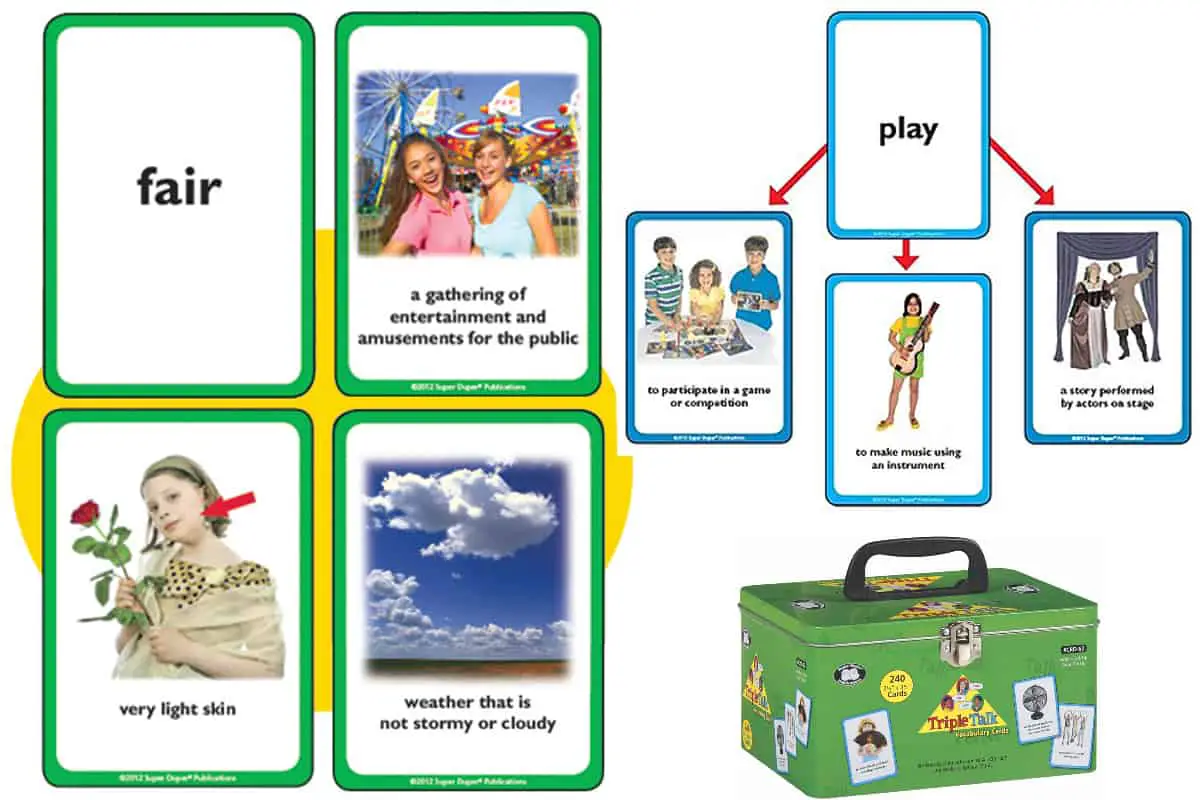
★★★★☆
For Teachers | Age 7-9 | 2-4 Players | Grades 2-3
Triple Talk Vocabulary Cards
The photo-definition cards are classified according to three levels of difficulty:
- Level 1: definitions that are most familiar to students
- Level 2: definitions that are not common or less known by students
- Level 3: definitions that are generally unknown to students (the words are defined as parts of speech such as nouns, verbs and adjectives)
I give four stars because
- The content is well-thought, with 3 levels of progression in difficulty noted on the cards
- The gameplay is easy to understand and exciting (the pictures help visualize the meaning)
Just for Laughs (Super Duper Inc)
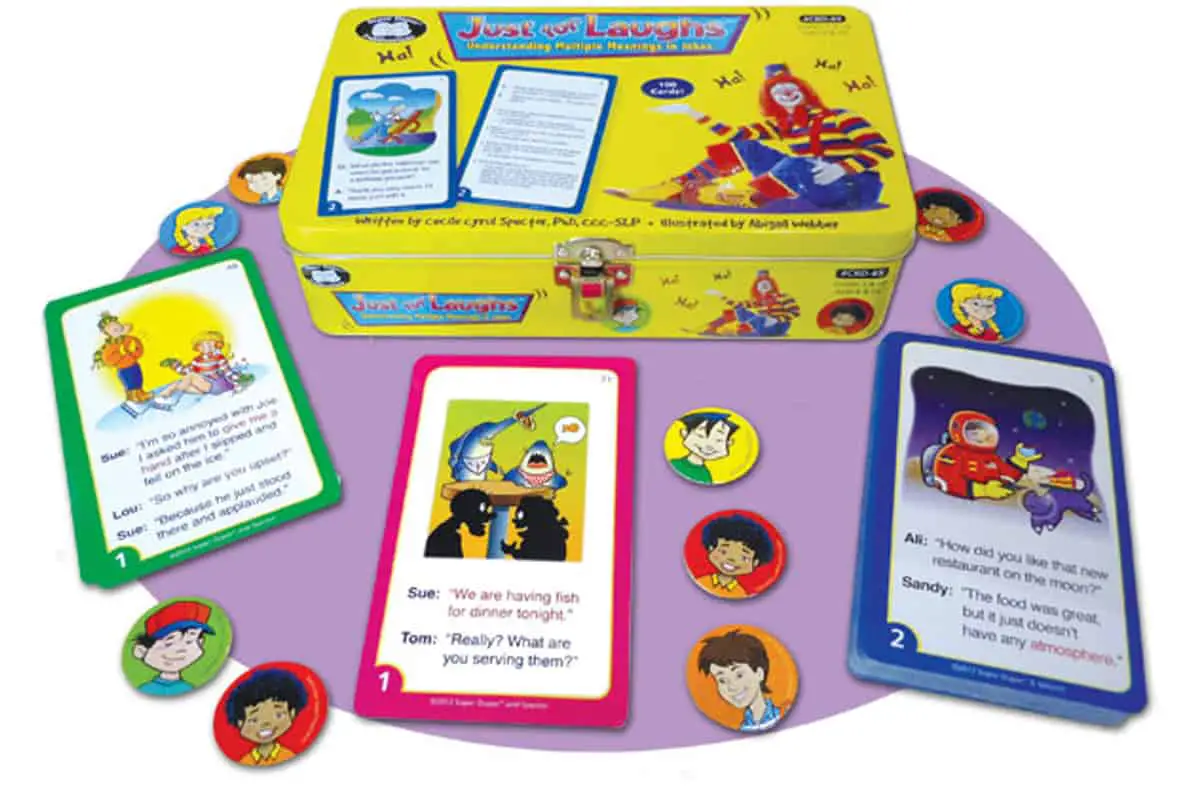
★★★★☆
For Families and Teachers | Age 8-10 | 2-4 Players | Grades 3-4
In Just for Laughs
- 40 cards with multiple meaning words
- 30 cards with multiple meaning phrases
- 30 cards with multiple meaning sentences
The front side of the card contains a funny drawing and a joke. the other side has questions and answers about the joke, related to the multiple meanings of the word, phrase, or sentence.
I highly recommend “Just For Laughs” because
- Illustrations help players understand the joke
- Explanations are properly sequenced and labeled
- Children love jokes. Explainig in details how multiple meaning jokes work might seem dull (it is often sayed that a joke requiring an explanation is not funny any more), but in fact it can be fascinating for children to discover how they can crack jokes
Super Sleuth (Educational Insights)
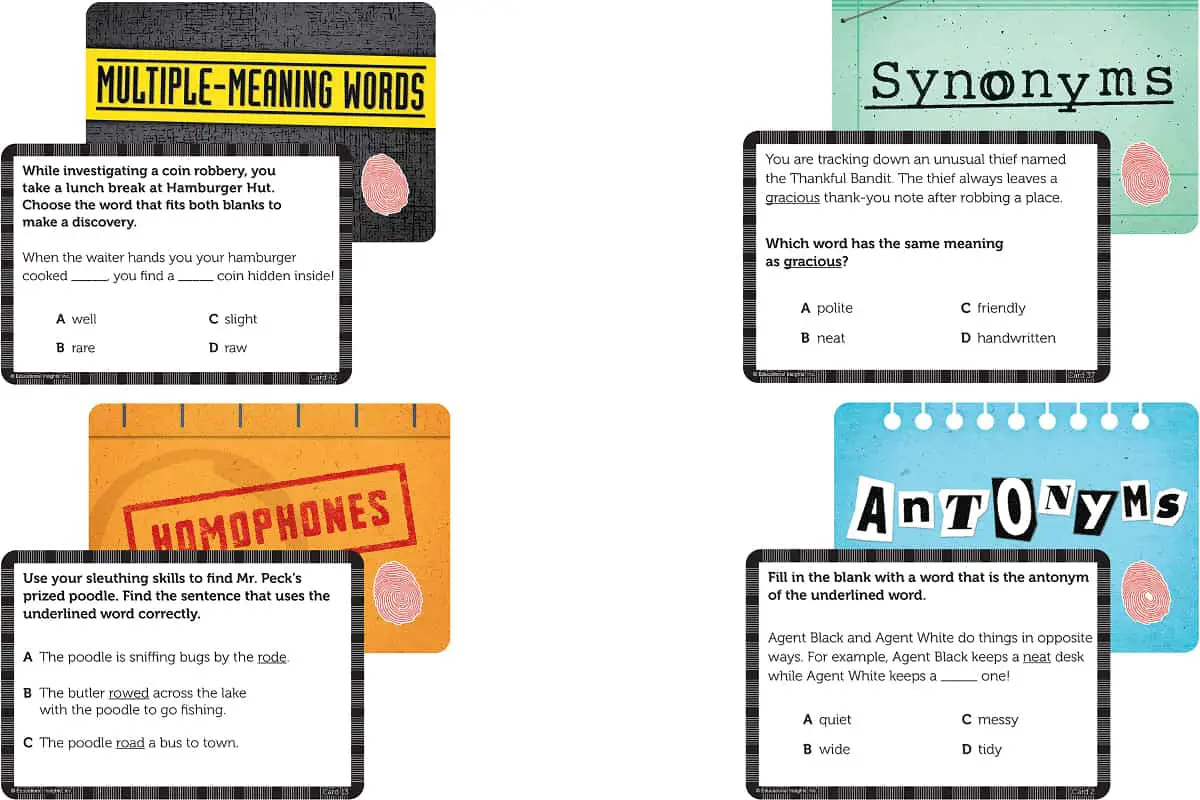
★★★☆☆
For Teachers | Age 8-10 | 2-4 Players | Grade 3-4
Super Sleuth
- Synonyms
- Antonyms
- Homophones
- Multiple meaning words
The object of the game is to collect three badges in each vocabulary category.
There are 48 badges to collect from 184 cards and 16 special assignment cards. Players check their answers using a special decoder.
The first detective to collect 12 badges wins the game and earns the title “Super Sleuth”.
Here are some pros and cons:
- It is self-correcting and exciting. Children enjoy using the special decoder or the spy glass.
- It really adds fun to the “classic” MCQ format
- However, there are no real mysteries (inherent problem with MCQs)
- Some vocabulary words are too easy (Kindergarten or Grade 1 level).
Word Waffle (Edupress)
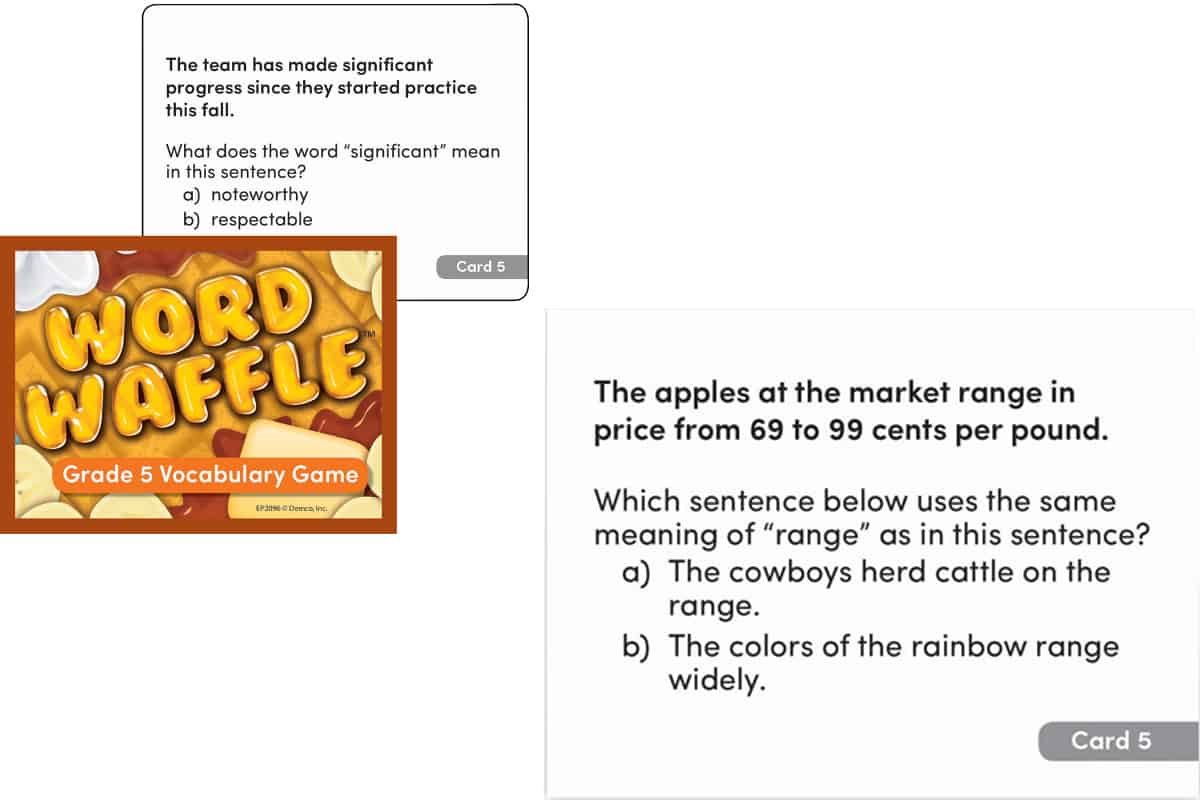
★★☆☆☆
For Families| Age 10-11 | 2-4 Players | Grade 5
In Word Waffle,
This game has 150 cards, 64 tokens, and an instruction guide.
The object of the game is to have the greatest number of tokens kept at the end of the game. Players lose all their tokens when they answer incorrectly, but they have a chance to get them all back if they draw a full plate card. The playing time takes about 20 minutes.
I don’t recommend Word Waffle because compared to “super sleuth”, there is no effort to make MCQs more enticing. the game has answer keys though, which enables children to play it autonomously.
Early Learning Language Library (Key Education Publishing)
Vocabulary flashcards are also a convenient way to organize vocabulary learning (especially by managing the repetitions). They are often categorized according to purpose or themes.
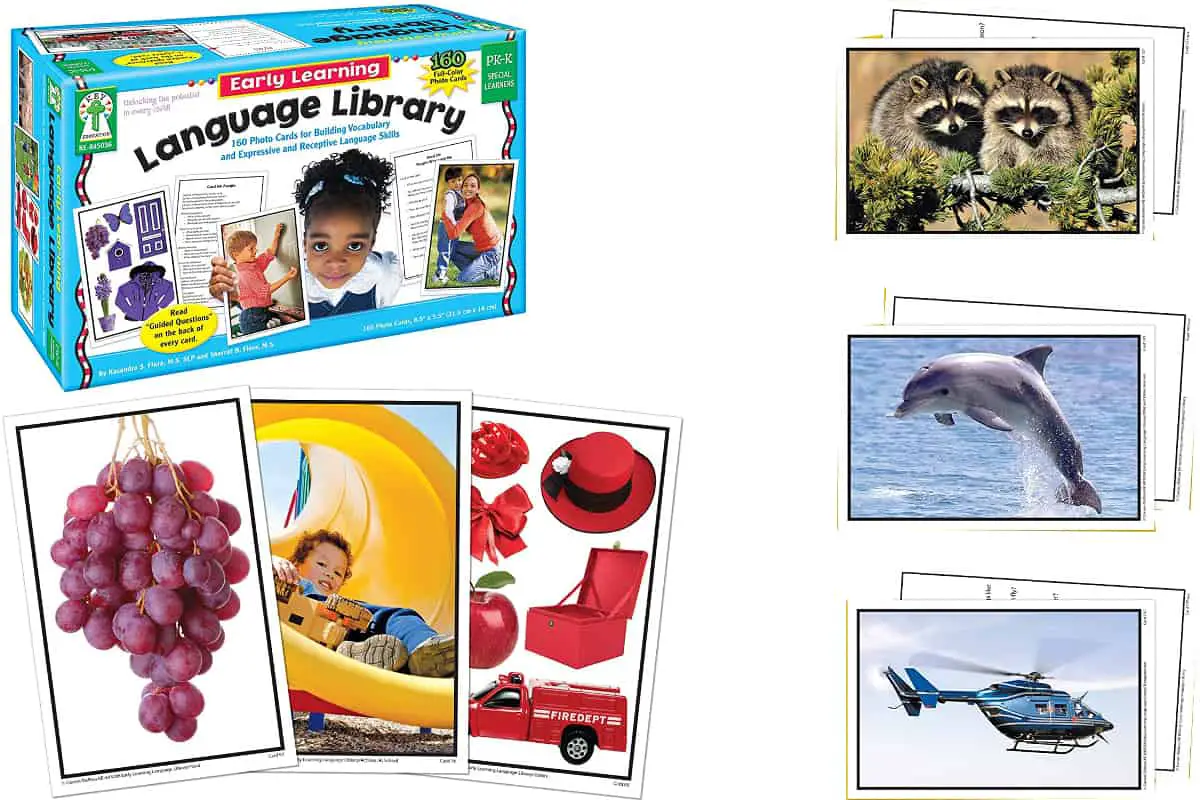
★★★★☆
For Teachers and Families | Age 3-5 | 2-4 Students
Early Learning Language Library
- Actions: At School
- Actions: Taking Care of Myself
- Actions: What are they Doing?
- Colors
- Emotions
- Farm Animals
- Food
- Wild and Water Animals
- Forest Animals
- Pets
- Transportation
A resource guide contains word lists and game ideas.
The photos are quality real-life pictures (however, some are obsolete).
The backside of the card contains prompt questions that can help children with speech delays express their ideas
Other Types of Vocabulary Games
If you are interested in more vocabulary games, you might want to check the post “12 Vocabulary Board Games for Schools and Families“.
How Does Vocabulary Develop?
Vocabulary is of course built progressively every year, but to schematize it can be divided into the following three layers:
- Basic vocabulary comprises about 8000 word families and includes early reading words, sight words, and parts of speech (nouns, verbs, adjectives). These words occur in daily conversations. Most are generally known at age 8 or Grade 3.
- High-frequency vocabulary consists of 7000 word families. These words often carry multiple meanings, and comprise many abstract words. They are used in a variety of domains which are crucial in reading and speaking. They are generally expected to be mastered by 13-year-olds, or at the end of middle school.
- Low-frequency vocabulary includes jargon or specialized vocabulary in specific domains like technology, occupation, school and more. They are rarely used unless needed in the situation. Knowing them or not depends on your interests, competences and experiences. Adults generally know around 30000 words, half of them being low frequency vocabulary.
Edudingo.com is a participant in the Amazon Services LLC Associates Program, an affiliate advertising program designed to provide a means for sites to earn advertising fees by advertising and linking to Amazon.com. We also participate in other affiliate programs which compensate us for referring traffic.
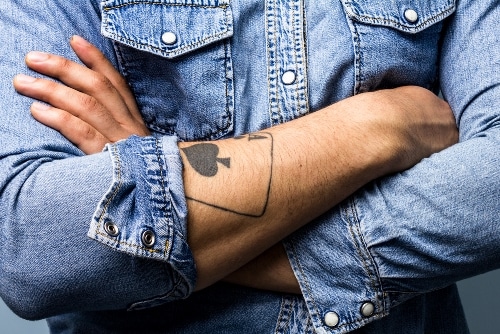
Want a fresh, new ESL teaching tool that isn’t a total gamble?
Deal your students a winning hand with card games.
All you need for these awesome in-class activities are some cards.
That means they’re simple, flexible and cost-efficient.
As the teacher, you get to make up the rules. Since they’re easily customized, you can play around with all kinds of variations on classic card games. You’ll hold teaching tools for whatever vocabulary or grammar point you’re working on in class.
Teaching them card games not only builds language, but it also builds cultural knowledge. From elementary schools and retirement homes to casinos and college parties, card game are an important part of our culture. Wherever you go in the world, you’re bound to find some regionally-popular card games.
The card games we’ve assembled here are not only timeless, international favorites, but they’re also perfect teaching tools for an ESL classroom.
Download:
This blog post is available as a convenient and portable PDF that you
can take anywhere.
Click here to get a copy. (Download)
Why Are ESL Card Games Legitimate Teaching Tools?
Never underestimate the power of being different or exciting.
Used correctly, games in the ESL classroom will enrich your lessons.
But how?
Make things fun and engaging for everyone
ESL games perk up your class’s interest and provide a mental break from stressful studying. They can trick the most apathetic students into learning something new. Games reinforce the idea that the classroom is a fun place, and that learning English is a fun activity. For another source of fun, interactive learning, you’ve got to try FluentU.
FluentU takes authentic videos—like music videos, movie trailers, news and inspiring talks—and turns them into personalized language lessons.
Reduce teacher talking time
You should always be on the lookout for new activities that will minimize the time you spend talking and shine that spotlight on your students. They’re not in class to just listen to lectures, they’re in class to practice their English as much as humanly possible.
By introducing them to some card games, you’ll provide your students with a way to practice English among themselves and try out their newly-learned grammar and vocabulary.
Build relationships
The student-teacher relationship, as well as the peer relationships between members of the class, can be greatly strengthened by having everyone laughing together.
Teach and reinforce material
Games involve repetitive actions. Students will repeat the same actions and English phrases over and over again, ingraining this in their memories for the long-term. For instance, when playing “Go Fish,” students will need to ask questions using the same sentence many, many times.
By the end of a few rounds, it will be second nature to say “Do you have any…?” You can use this characteristic of games to your advantage, and use them to teach the most difficult vocabulary and grammar concepts.
Let students take ownership of English
Games help students realize that they’re not just learning English for the sake of learning English. Games teach them that there’s more to the English language than just, “Hello, my name is…”
It’s not something boring and dry that they’re simply “supposed” to learn. Your students will come to understand that they’ll be able to have fun and play around with the English language the same way they do with their native language.
Encourage creative thinking
Many of these games involve students having to spell words, identify the right vocabulary and come up with their own sentences for gameplay. This means that they’ll need to get the gears in their brains spinning and be creative with the English they already know. Plus, since games are fun, their brains will decide that making up new English sentences is fun, too!
An ESL Teacher’s Motivations Determine a Game’s Success
I taught hundreds of middle school students while living in South Korea. In the beginning, I used games because I was scared to death of being boring. As a result, I was under constant pressure to be exciting, and I doubt my students learned much.
Eventually I let go of perfection. I used ESL games as a teaching tool, and my classes improved enormously.
Your own classes will suffer if you use games:
- as time for you to take a break
- because you didn’t know what else to do
- to prove to your students that you are incredibly interesting
If you use ESL card games for the right reasons, the energy in your classes will increase. The teaching relationship between you and your students will also be strengthened.
7 ESL Card Games You’ve Gotta Have Up Your Sleeve
1. Spoons
This hilarious card game translates into effective ESL spelling practice for all levels and ages.
It works best for smaller groups of 4 or 5 students. Things tend to get pretty crazy with big groups, but it can be done.
Be forewarned, the cards require a lot of preparation in advance. However, if you make them correctly and have them laminated, they’ll last a long time.
Preparation
In a Word document, create a table. Each square in the table should be about 2 inches by 2 inches. These are your game cards! Type up the alphabet, with one letter per square. Create about 20-25 squares for each letter of the alphabet. Print the document (laminate if you can) and cut the tables into the game cards.
These same cards can be used for a homemade Scrabble game, as well.
How to Play
Choose about 10 vocabulary words and write them on the board where everyone can see them. Dump the cards face up in the middle of the table or desks. Then put plastic spoons or unsharpened pencils in the center.
The quantity of these is important, through—there must be one less than the number of students playing. For example, if there are five students, put out only four spoons or pencils.
The students will each spell the same word from the board by choosing letters from the pile. When one student finishes, he/she takes a spoon. As soon as that happens, the other students must take a spoon also. The student who does not get a spoon writes “S” on a piece of paper (or “P” for “pencil”). Whoever spells “Spoons” or “Pencil” first loses.
2. Memory
One reason this game is so popular is that everyone enjoys the challenge it poses.
It’s another ESL game that transcends all levels and abilities.
Preparation
Create paper cards with key vocabulary words on them.
You’ll want to create a grid of at least 7 by 7 (49 cards) for small groups of intermediate and advanced students, and can make significantly larger grids for more advanced students and larger groups of students. Teeny tiny grids of cards (think 4 by 4, 16 cards) can be made up for young children and beginning students.
You don’t just have to limit yourself to vocabulary words, either. You can use pictures, numbers or colors for young and beginning level students. You can also kick the difficulty up a few notches and provide matching verb conjugations.
How to Play
On your turn, you can select any two cards to flip over. If they are a pair, you can keep the cards and go again. If not, turn the cards back over in their original spot, and your turn is over.
There are a variety of ways to play Memory, depending on your classroom’s technology.
1. Place the cards at the students’ desks.
No matter the students’ ages, it’s best to laminate the cards. Otherwise they become dog-eared and torn up very quickly.
2. Put the cards on the board with magnets or small pieces of tape.
Be especially careful that the tape won’t damage the board. If possible, have the cards hung before class starts to save valuable time. Young students become very antsy and disruptive when they have to wait.
3. Create a PowerPoint game.
For the tech-savvy, you can create a PowerPoint with numbers in the squares, or find a free template online. The students first choose a number. A word or picture is revealed which then disappears. The students choose another number, trying to find a match.
3. Go Fish
This old favorite is for beginning level students and never fails to get everyone talking.
Preparation
You can either use a traditional deck of cards and focus on structuring questions and identifying numbers, or you can make up your own set of illustrated cards for key vocabulary. In Korea, the students’ textbooks usually would have pre-made flashcards in the back of the book that students punched out. These were perfect for Go Fish when they were numerous.
How to Play
Divide students into small groups of 4-6. Deal out 5-7 cards per students, and then dump the rest of the cards face down in the center. Mix them up well!
You know the drill from here on out: First students lay down any matches they have in their hands. Then students will go around in a circle asking each other if they have a match for their particular vocabulary words or numbers. If the other student has a match, he or she has to pass it over to the questioner.
The successful questioner can keep asking for matching cards until they finally get told to “Go fish!” The goal is to have no cards left in your hand, because you’ve laid down matches. With traditional playing cards you’ll need to get all four numbers (one in every suit) to lay down a set. With vocabulary, it’s up to you to decide how many makes a full set, though pairs work well for younger students.
The matching cards get set aside into a pile. At the end of the game, the student who finished their hand first may be the winner—but the ultimate winner will have the most matching sets of cards in their pile.
It’s great for practicing questions, answers and easy vocabulary, like:
Do you have _______________? (a fish, book, house, etc.)
Yes, I do./No, I don’t. Can you give me a ____________? (pencil, dress, spoon, etc.)
Yes, I can (give it to you).
No, I can’t (give it to you).
Sorry, go fish!
Feel free to be creative and adjust the asking phrases to match your key vocabulary. For example, my sixth graders had a unit where the target phrase was “How do you say ~ in Korean/English?” We used their textbook’s flashcards to play Go Fish, but instead of “Do you have ~,” they would ask, “How do you say ‘apple’ in Korean?” If the student had the corresponding flashcard with the Korean word for “apple,” it was a match.
As always, be sure to laminate your cards if you can, or you’ll be remaking them in no time. It’s a good idea to glue words or pictures on to darker paper so that fellow competitors can’t see through the cards.
4. Uno
No, no. Despite the name, this game isn’t for teaching Spanish. It’s actually perfect for teaching your ESL students colors, numbers and a few basic phrases here and there.
This beloved game was a strong presence in many of our childhoods, and it’s so darn popular because it’s simple.
How to Play
Deal seven cards to each student in the playing group. Place the deck in the center and flip one card over to create the discard pile. Students will then take turns playing the cards in their hand on the discard deck.
In case you’re a bit out of touch with your inner child and need some refreshing on the rules, the student who’s actively playing their turn must match the last discarded card’s number, color or command.
For instance, a red 8 can be played on any other red card, a blue “draw two” may be played on any other blue card, and any color “draw two” can be played on any color “draw two.” Black cards can be played at any time!
Because the card matching is super visually-oriented, it’s even easy for beginning English students to pick up on. Now, how do they practice their English with this game? Have the playing student speak the number, color and command (if applicable) of each card out loud while they play it. This will help them practice identifying colors and numbers quickly and naturally.
When a student gets down to one single card, have them shout “One card!” instead of “Uno!” if you like. The winner is the student who gets rid of all their cards first.
5. Kings
Some of you might recognize this one as a drinking game (also known as “Circle of Death,” though we highly recommend sticking with the “Kings” name). I won’t try to slip that one past you. It is! But you can rework this classic party-night game to be an excellent, engaging and activity-driven game for in-class English practice. It’s also wonderful for getting the “wiggles” out of your more energetic classrooms.
Preparation
Create a sheet of rules for the game. You’ll need to assign a different action to every number in the deck (Ace through King). These rules can be created with the input of your students before gameplay starts, or you can make it up ahead of time at home.
Not sure what kind of rules to make? To get your creative juices flowing, here’s one set of rules you could use.
How to Play
The students simply go around in a circle drawing one card on their turn, and then everyone does the activities corresponding to the selected card. Students can keep the list nearby for reference, or you may elect one student to be a “rule keeper” and have them read off what every student must do.
This works on the students’ English comprehension skills, because they’ll need to either read or hear the action and respond accordingly. Those who cannot perform the actions sit out the round, and the winners are the ones who can jump through the hoops until the deck runs out!
6. Dictatorship
This one is all gameplay, no preparation. Just get yourself a deck of traditional playing cards, explain the rules and you’re good to go!
For this one you’ll want to break larger classes into smaller groups. Each group needs its own deck.
How to Play
To play, everyone draws a card, and the highest valued card is the “dictator” for that round. Feel free to call them the “president,” “leader,” “commander” or any other term that suits your fancy if dictator is too harsh or complex.
Whatever you decide, this student officially gets to call the shots for one round. They’ll decide on a couple of fun “rules” that the rest will have to follow depending on the cards they draw. For example: “Everyone with a red card has to dance salsa for five seconds” or “Everyone with a diamond has to jump up and down.”
You can provide them with a list of possible actions if they’re still in the process of learning action verbs and activities like these. Definitely write the sentence structures they’ll need on the board to command their fellow classmates.
After determining the actions everyone will need to do, the dictator will then deal out the cards in a circle. Once the cards are out and everyone has followed orders, reshuffle the deck and pass it to the next student on the dictator’s left (or right). Go around in a circle until everyone has had a chance to be the boss!
One little tip: Give the dictator a limit for how many “rules” they can impose on their subjects for each round—otherwise things might get out of hand. I’d suggest no more than 2-3 rules per round. For lower levels, just one rule will suffice because the other students playing might forget what they’re supposed to do while waiting for the cards to be dealt!
If you’re in the mood for some silly and boundless fun at the end of a class period? Let them command to their heart’s content.
7. Cards Against Humanity
Perfect for adult students, advanced students and only somewhat appropriate in a (very) casual learning environment. You probably won’t want to bring this one into school—and you’ll definitely need to get an “okay” from a higher-up depending on where you teach ESL.
There are a few ways to modify this game and make it school-friendly, so stay with me here.
Preparation
For the unanointed, this is not your grandma’s card game. It’s full of deliciously explicit language, offensive statements and other content that is absolutely not politically correct. How the heck is this great for ESL, you’re wondering?
If you can get away with the official Cards Against Humanity decks, it’s just awesome for helping adult and advanced students to learn more about popular culture, puns, black humor (which is honestly quite a lot of American and British humor) and well-known people and events in the English speaking world.
It’s also hilarious. It encourages students near fluency to totally own the English language and have fun with it.
You will definitely want to remove any cards with exceptionally obscure references. You may also want to create some of your own cards to add to the deck—or craft your own deck entirely based on references and humor that your particular class will understand.
How to Play
Each student will be dealt 8-10 white cards, each of which contains a noun or gerund. One player draws a black card and places it face up for all to see. This black card will have a question or fill-in-the-black statement. Each player (except for the one who drew the black card this round) will put down the white card which answers or fills in the black card’s statement as hilariously as possible.
The player who drew the black card may choose the winning white card, and thus that round’s winning player, based on whatever they feel like—usually whichever card made the statement most humorous.
While it’s loads of fun with mature content, most of you out there probably won’t be able to use these cards for ESL students. However, you can print up you own deck of cards quite easily, making it a fun humor-driven game that expands students’ horizons in terms of English language creativity.
Another school-friendly alternative is the classic Apples to Apples, which follows the same idea, except that it’s recommended for ages 12 and up—so you can surely play it at school.
How to Avoid ESL Card Game Pitfalls
There are a few elements of card games that are sometimes challenging in ESL classrooms. But no problem in the ESL classroom is without a simple solution!
Cultural blocks
Be sure card games of any kind are fine in class. While volunteering in the Philippines, I was told we couldn’t have card games in the women’s shelter. Cards were immediately associated with gambling and the irresponsible use of money. Just to be careful, ask if there are any cultural taboos that would cause you unforeseen problems.
No one understands the game
This happened to me often in the beginning, causing embarrassment. The one lesson I learned was this: Even the easiest game can be hard to understand for a person who is learning your language. If you have a co-teacher, be sure to explain the game’s rules before class first. He/she will then be able to translate when all else fails.
Also, be sure to practice explaining the ESL game before class. Know exactly what you’ll say. It’s helpful to demonstrate things like shuffling, passing a card or taking a spoon.
The class is too noisy
This is a particular danger when playing Spoons. When students catch on to how it’s played, the noise level will increase dramatically.
You have a few options here.
For adult students who are more mature, you can mention the need for quiet before playing. They should cooperate.
For the younger students in middle school and high school, you’ll have a challenge. Some schools have an ESL lab that is far from other classes, and noise isn’t an issue. For those without an isolated classroom, you’ll have to have strong classroom management skills. The more cooperative students will probably respond to firm reminders. You may have to stop the game altogether for classes that are more strong-willed.
Sometimes, however, you can see trouble coming from a mile away. You know which classes just can’t handle the excitement, and you’ll have to prepare a less rowdy activity.
Game materials are destroyed by students
In Spoons, it’s inevitable that a few plastic spoons will be broken. Have plenty of spares on hand—they’re cheap anyway. That’s why unsharpened pencils are better; they’re just sturdier and survive use by multiple classes.
Definitely laminate. If you can’t do that, then break out the clear tape. Avoid the smaller rolls and buy the wider packaging tape. It works just as well as laminating.
Keep an eagle eye on the rowdier students and intervene when they get too rough. Circulate around the room, picking up materials that fell to the floor.
When the ESL Card Games Are Finished…
Remember how you carefully counted out the game cards so that every group would have exactly the same materials?
You won’t get them back like that.
Students will lend cards to other groups and pick up materials that aren’t theirs. Some will actually keep the cards, though that might be accidental (or not). Inevitably you’ll have to sort everything again, putting it all back in plastic bags for safe keeping. Though a little tedious, remember that the class really was fun.
Bringing fun into the ESL classroom takes creativity and dedication. Those two qualities are what make you such a great teacher.
Though the preparation can be hard, when you are laughing with everyone else, you’ll forget about the negatives. What you will remember for a long time to come are the smiles on your students’ faces.
Download:
This blog post is available as a convenient and portable PDF that you
can take anywhere.
Click here to get a copy. (Download)
How to use this teaching resource
This is one of my favourite teacher resources.
It provides some really simple but effective and fun word card games ideas as well as activities for general spelling and word study.
I would use this document almost every day to plan for the following types of activities……
- Daily group activities and/or tasks – at least one session per day involved some type of dolch sight word list or theme word card game or activity.
- Home sight word games and activities – Many Teacher Members are sending the full version – ‘101 Fun and Educational Word Card Activities’ home as a reference document for Parents – communicating ideas and ways to help their children learn sight words at home.
- PLUS they are fantastic for those fill in, impromptu and early finisher activities.
101 VOCABULARY / WORD CARD ACTIVITIES….
a sneak preview…..SEE ABOVE DOWNLOADS FOR FULL FREE DOWNLOAD
1. Immerse your Learning Area…
- Absolutely immerse your learning area with words – hang them from the ceiling like a ladder, have them on the windows, pop them on your bulletin board displays, have full class sets in themed boxes (small washing powder boxes work well) or hanging pockets ready for children to use for reference and games everyday…
- Children need to be absolutely enveloped by all sorts of words, eg. theme words, sight words, phonics words, CVC words and more.. EVERYWHERE !
2. Syllables and Sounds Mapping…(MY ALL TIME FAVOURITE ACTIVITY – IT JUST HELPS SOOOOO MUCH PARTICULARLY WITH WRITING)
- Practise clapping or moving to the syllables of each word.Use whiteboard markers on laminated cards to stroke out the syllables in each word (don’t forget each syllable has a vowel).
- The sounds (or graphemes) within each syllable are then mapped using a dot for 1 letter graphemes, and underscore for 2 or more letter graphemes.
- Also can – Bring up the pdf words file on the electronic whiteboard and use digital pen to mark the syllables and sounds as a whole class.
- Also can – Make up a chart with headings – ‘Word’ ‘How many Syllables’ ‘How Many Sounds’ eg. The word ‘river’ has 2 syllables and 4 sounds so would look like this …….
3. Twister Chart
- Make a ‘twister’ style chart with chalk on a concrete floor, using letters instead of colours.
- Children choose a word and place their feet and hands on the letters as they spell out the words.
4. Make a Vocabulary / Word Dictionary...
- Each child has a ‘scrapbook’ with each letter of the alphabet written at the top of every 2nd or 3rd page.
- Whenever you present a new set of words – print your chosen word cards in black and white reducing the size to about 4in 1 in your printer settings.
- Children cut these words out and glue them into the appropriate initial letter of their ‘dictionary scrapbook’
- Great for writing reference and word practice – by the end of the year they have a full scrapbook of all the words they have been ‘exposed’ to.
5. Mini Words…
- Print off smaller size words in black and white using the printer settings (for example 4in1 page).
- These words are then cut up and put into a small lunch container to practise at home.
- Send a copy of these ‘101 Word Card Activities’ home with parents as a reference for activities with these cards.
6. Who Am I ? Game…
- *Have your selected word cards on display.
- *Children take turns giving ‘who am I’ clues for a chosen word.
- *For example, I am yellow, I have 5 letters, I end in ‘y’.
- *Other children guess the word.
7. Hangman…
- *Have your selected word cards on display.
- *Play ‘hangman’ using these cards as reference.
8. Find-a-Word in Reading Books…
- *Using your pile of chosen word cards – children find each word in class reading books.
- *Write down each word and how many times they found it.
- *Could use a ‘tally’ for this.
9. Dominoes…
- *Using your chosen word cards, deal them out so that each child has the same amount.
- *Children take turns placing their cards down making sure the last letter of one matches the first letter of another word card as in dominoes style.
10. Interactive Whiteboard Wordplay…
- *Set your IWB so that your chosen cards pdf file displays.
- *Children circle the letters, sounds, and patterns within the words.
11. Chinese Whispers…
- *Children are sitting in a circle.
- *First child picks up a word card and whispers the word to the child next to them
- *The word get ‘whispered’ around to the last child who says to word out loud.
- *Word card gets held up to check if correct.
12. Dismissal Words…
- *Grab a set of word cards and as children are dismissed or move to another activity – ask each child to say the word or point to a letter / sound in the word etc as they move on…
13. Circle Smaller words within Words…
- *Use whiteboard markers to circle smaller words within the laminated word card words.
- *For example – ‘ball’ – ‘all’.
14. Chalk Words…
- *Children go outside and practise writing their words with chalk on the concrete.
15. Handwriting Practice…
- *Children use whiteboard markers to practise tracing over a set of laminated word cards.
16. Word Classification / Grouping…
- *This is a great activity for early finishers also.
- *Grab a set of cards or more classify/group them according to all sorts of criteria…
- *number of letters
- *words with double letters
- *compound words
- *words that rhyme
- *words with certain phonic sounds
- *same initial letters
- *same ending letters
17. Flashlight Words….
- *Have your chosen word cards on display.
- *Turn off the lights and use a flashlight or torch to flash on each word card.
- *Children say the word as you flash on them.
18. Around the World Words...
- *Children play this in continuous pairs.
- *Flash the word card to the first pair, first child to say the word correctly, moves on to the next child to make a pair.
- *Another card is flashed – first child to answer correctly moves on to the next child and so on..
19. Tic Tac Toe Here I Go…
- *Have your chosen word cards displayed.
- *Children or Teacher uses a pointer to sing as they point to the words in random fashion…’Tic Tac Toe Here I go, Where I Land I Do Not Know’
- *Stop on a card – children say the word.
- *Is fun to go really fast with this and children love being the ‘teacher’.
- *This has always been a simple favourite wherever I have used it.
20. Swat the Word…
- *Have the chosen words displayed.
- *Children use a flyswat to ‘swat’ the words as they are called out.
21. Stepping Stones…
- *Place chosen word cards on the floor in random fashion.
- *Children take turns stepping on the stones (word cards), saying the words as they step on each one.
- *Children be careful not to fall off into the river full of crocodiles
22. Musical Words…
- *Children sit in a circle.
- *1-5 word cards are passed around as music plays.
- *Once music stops, children with cards, stop and look at them and say the word or say something interesting about the word eg. double letters etc – continue with the music.
- *Can build it up to 20 or more cards being passed around good fun.
23. Word Walk…
- *Children grab 1 or more cards , depending on the age of level of the children.
- *Children walk around the room or school (under supervision) looking for their words on signs, books, around the environment…
- *Children keep a tally of how many times they see each word.
- *To make it fun children could have their own ‘word wands’ made from dowel or ‘fairy wands’ purchased from cheap shops.
24. Playdough Words…
- *Children make words up using playdough.
- *If you make the word cards larger size, they can place the play-dough over the top of the letters..
25. Coin Toss / Beanbag Toss…
- *Place selected words on the floor face up.
- *Children take turns to toss the coin, or beanbag onto a word and then say that word or say something interesting about the word eg. double letters etc.
- *Make this more difficult by asking the ‘tosser’ to throw onto a specific word or other clues, such as – a word beginning with ‘b’ or a word with the sound ‘oo’ in it, or a word with 4 letters for example.
26. Crisscross Words…
- *Children write their words downwards, then fill in the missing letters…
27. Letter Stencils and Letter Stamps…
- *Children make up words from the selected word cards using letters stencils or letter stamps.
28. Magnetic Letters…
- *Children make words using magnetic letters.
- *A great way to do this for individual use is to use cheap baking trays for each child to place their magnets on.
29. Beat the Clock…
- *Using the word cards, how many times can each word be written in 1 minute.
- *Great to work in pairs with one child writing and one child doing the timing.
30. Beat the Clock Reading…
- *Hold up the words – how many words can be read out loud in 1 minute.
- *Again, this could be done as a class or in pairs with one child saying the word while the other times.
Copyright – K-3TeacherResources.com
Comments & Reviews
Flashcards at Dawn
ESL Flashcard Game — Vocabulary and Speaking: Identifying Vocabulary — Group Work — Young Learners — 10 minutes
This entertaining ESL flashcard game can be used to practice any vocabulary or language point. One student from each team comes to the front of the class. Have the two students stand back to back. Give each student a flashcard containing the target language. Each student holds their flashcard in front of them with the picture side facing away. Both students then take three steps away from each other before quickly turning around (similar to the pistols at dawn scenario). The two students then race to call out what’s on the other student’s flashcard. The first student to correctly call out what’s on the flashcard scores a point for their team. Play until all the flashcards have been used. The team with the most points at the end of the game wins.
Grab it
ESL Flashcard Game — Vocabulary: Matching, Identifying, Providing Vocabulary, Answering Questions — Group Work — Any Level — 15 minutes
You can use this engaging flashcard game to review or practice a variety of language or vocabulary. Stick flashcards of the target language or vocabulary on the board. Each team lines up at the back of the room. For lower-level students, call out a word from one of the flashcards. One student from each team runs to the board. The two students then race to grab the corresponding flashcard and repeat the word. You could also call out a word, and have the two students race to grab the opposite flashcard. For higher-level students, describe a word and have the two students race to find the flashcard being described. You could also ask a question, and have the two students race to find the corresponding flashcard to answer. For all versions of the game, the first student to grab the correct flashcard and respond appropriately keeps the card for their team. Repeat the game with two more students and so on. The team with the most flashcards at the end of the game wins.
Mr Wolf
ESL Flashcard Game — Speaking: Asking and Answering Questions — Elementary (A1-A2) — 10 minutes
This flashcard version of Mr Wolf is ideal for practicing a variety of yes/no questions and short answers. You are the wolf. You stand at one end of the classroom with a flashcard. The other students line up at the other end of the room next to the wall. Show the students your chosen flashcard, e.g. a flashcard of a car. Ask the students questions about the flashcard that would get a ‘no’ response, e.g. ‘Is it a motorbike?’ Every time the students answer no (e.g. No, it isn’t.), they take one step forward. When the students are close to you, ask them a question about the flashcard that would get a ‘yes’ response, e.g. ‘Is it a car?’ When the students answer ‘yes’, you chase the students and try to tag them out before they reach the wall at the other end of the room. Whoever is tagged is out of the game. Repeat the game with a new flashcard and so on. The last student left in the game wins. You can also play the game with a strong student being Mr Wolf, or you can have the students who are out of the game become wolves and help you ask questions and chase students.
Sumo
ESL Flashcard Game — Vocabulary: Identifying Vocabulary — Group Work — Young Learners — 15 minutes
Here is a fun flashcard game to play with young learners. All the students form one large circle. Choose one student from each team to play first. The two players stand facing each other in the centre of the circle and take on the role of sumo wrestlers. Stick a flashcard to the back of each player. Tell the two players to place their hands behind their back and perform a ‘Sumo stomp’. When you say ‘go’, the two players move around and try to see what flashcard is on their opponent’s back. The two students are not allowed to touch each other and must keep their hands behind their back at all times. The students who form the circle must not help the players in any way. Award a point to the other team if this happens. The first player to call out what’s on their opponent’s flashcard scores a point for their team. Two new players then enter the centre of the circle, and the game continues with new flashcards and so on. The team with the most points at the end of the game wins.
The Flashcard Exchange
ESL Flashcard Game — Vocabulary: Matching, Identifying Vocabulary — Young Learners — 15 minutes
This engaging flashcard game can be used to practice vocabulary on a variety of topics. Arrange the students’ chairs in a circle (minus one chair). Ask the students to sit on a chair. The student without a chair stands in the middle of the circle. Give each student sitting in a chair a flashcard based on the same topic, e.g. sports. Call out two words based on the topic, e.g. football and tennis. The two students who have those flashcards must then swap places. The student in the middle has to try to sit in one of their seats while the two students are swapping places. If the student in the middle manages to sit in one of the chairs, the student left standing has to give their flashcard to the student who took their place. Then, call out two other words based on the topic and so on. The game continues until all the students have had each flashcard at least once.
Tiddlywinks
ESL Flashcard Game — Vocabulary: Matching — Group Work — Elementary (A1-A2) — 20 minutes
In this amusing flashcard game, students answer questions about flashcards. Begin the game by marking a start line on the floor at one end of the classroom. Spread out flashcards face up at the other end of the room. Give the first player in each team two tiddlywinks. Have the players line up at the starting line. Ask the players a question based on one of the flashcards. Players then race to flip their tiddlywinks across the room and on to the correct flashcard. The first player to land a tiddlywink on the flashcard gets to answer the question. If the player answers the question correctly, they score a point for their team. If not, the game continues until the question is answered correctly. Players then swap, and the game begins again from the start line with a new question. The game continues until all the questions have been answered. The team with the most points at the end of the game wins.
Whisper
ESL Flashcard Game — Listening and Speaking: Repeating and Forming Sentences — Group Work — Any Level — 20 minutes
This ESL flashcard game is ideal for reviewing words, sentence structures or tenses. Each team sits in a line facing the board. Put a set of identical word cards in front of each team next to the board. Whisper the same sentence to the student at the back of each line. The student at the back of each line whispers the sentence to the student in front of them and so on, down the line to the student at the front. The student at the front then grabs the flashcards that make up the words in the sentence and puts them on the board. The first team to put up the correct sentence scores a point. The student at the front then moves to the back and everyone moves up one place. The game is then repeated with a new sentence and so on. The team with the most points at the end of the game wins. For young learners, use picture flashcards and whisper three or four words to the students at the back. The first team to place the corresponding flashcards in order on the board scores a point.



